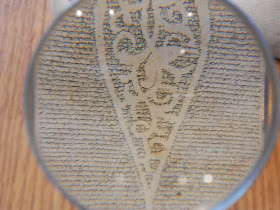
Before the novels and the Pulitzer, Edith Wharton made her mark by writing about garden design, interior decoration and what constituted good taste. Her first published book was
The Decoration of Houses (New York: Charles Scribner's Sons, 1897) in which she tastefully railed against Victorian decorating sensibilities and advocated for the use of more open spaces that emphasized the room, not the furnishings.

Wharton's next non-fiction work was a lavishly illustrated book about the architecture and surrounding gardens of Italian villas aptly named
Italian Villas and Their Gardens (New York: Century, 1905). The book included numerous drawings and photographs, primarily by Cornish Colony artist Maxfield Parrish. In Rauner's collection of Parrish's papers are correspondence with Wharton about the book as well as some of the original plate negatives used as inspiration for his illustrations.

One particularly interesting letter "sums up" Wharton's impressions of the various villas in Florence. The Villa Medici gets a nod of approval - "Open certain days. Don't fail to see it." The Villa Albani is dismissed as "Hard to see and not worth while." The Villa d'Este in Tivoli is "Wonderful of course. Always open." Entries on other sites contain additional information about permits, whom to obtain them from and when to visit to avoid complications due to school calendars or other potential hazards.
Ask for
ML-62, box 3, folder 43 to read the correspondence and
Illus P249wha for the first edition of
Italian Villas. The negatives are extremely fragile and are housed in Box 13 of the Parrish collection. A
guide to the Parrish collection is available.
 If we wanted to we could assemble an amazing cabinet of curiosities. Here is a favorite example. This is the entire text of the Koran executed in a miniature Arabic hand on a parchment scroll that is only 3 inches wide and 48 inches long. It can only be read with the aid of a magnifying glass, and rolls up small enough to be worn as an amulet.
If we wanted to we could assemble an amazing cabinet of curiosities. Here is a favorite example. This is the entire text of the Koran executed in a miniature Arabic hand on a parchment scroll that is only 3 inches wide and 48 inches long. It can only be read with the aid of a magnifying glass, and rolls up small enough to be worn as an amulet. The scroll, which was produced in 1101 A.H. (1689 A.D.), leaves off the titles of the 114 Suras and elides any indications of the verses to concentrate the text into as small a package as possible. Other than some gold leaf, all of the decorative elements are created by leaving gaps between words. Creating this manuscript was almost surely an act of devotion demanding tremendous patience and skill.
The scroll, which was produced in 1101 A.H. (1689 A.D.), leaves off the titles of the 114 Suras and elides any indications of the verses to concentrate the text into as small a package as possible. Other than some gold leaf, all of the decorative elements are created by leaving gaps between words. Creating this manuscript was almost surely an act of devotion demanding tremendous patience and skill.


